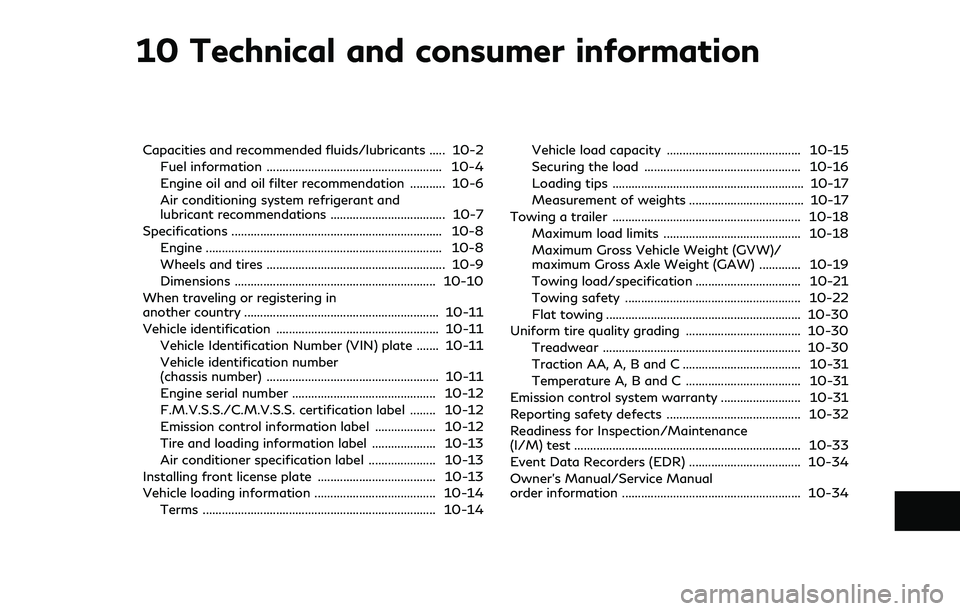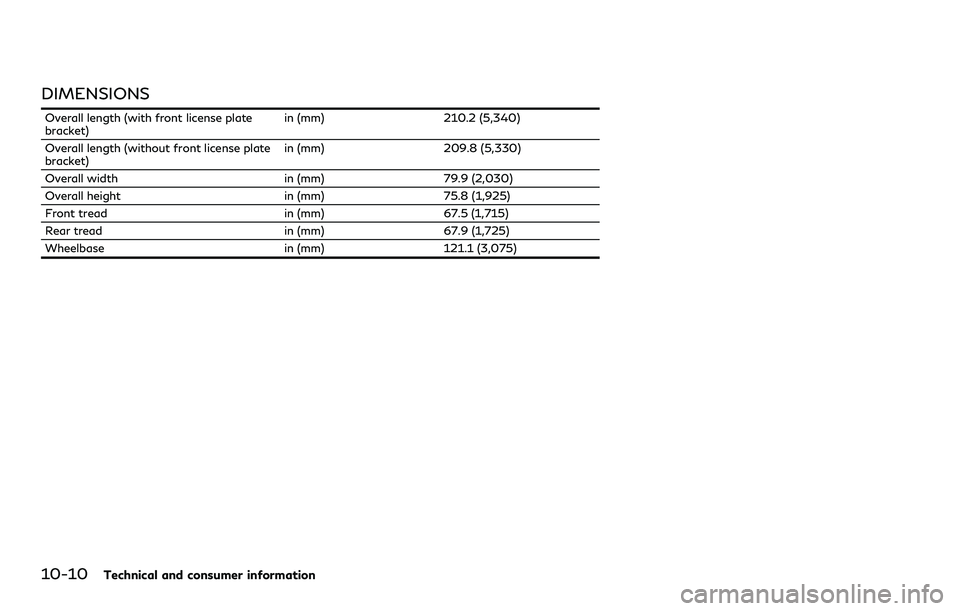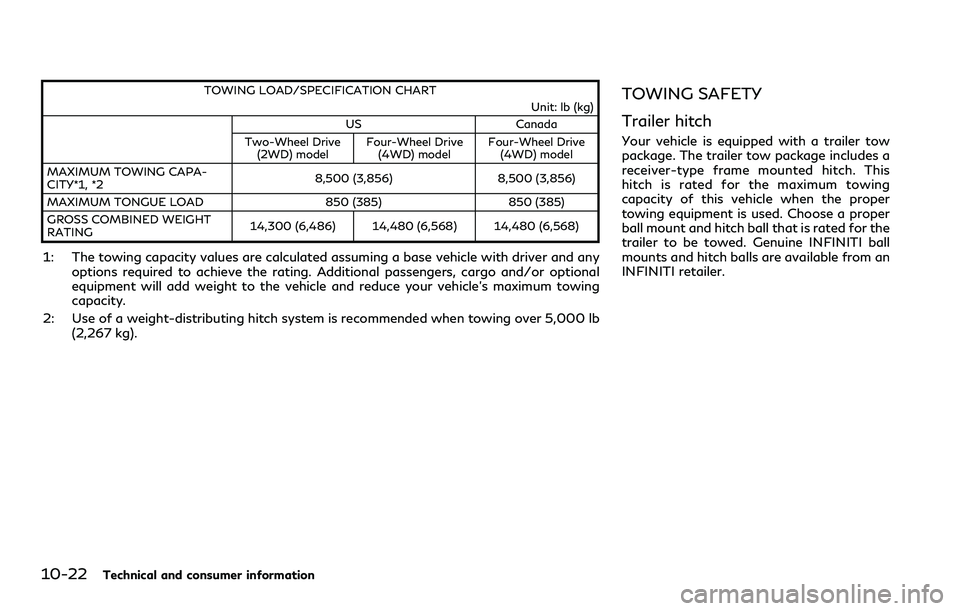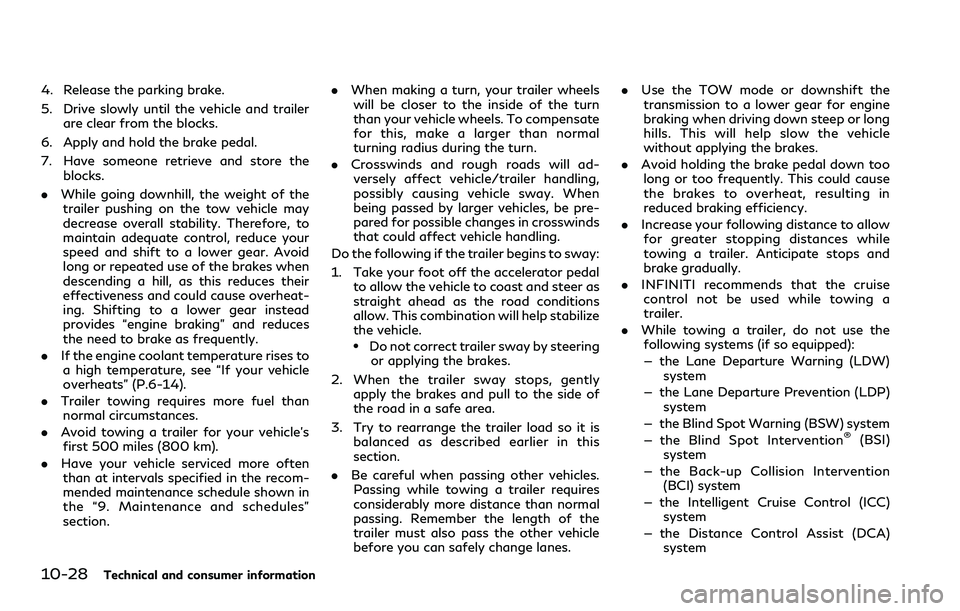wheel INFINITI QX80 2020 Owner's Manual
[x] Cancel search | Manufacturer: INFINITI, Model Year: 2020, Model line: QX80, Model: INFINITI QX80 2020Pages: 516, PDF Size: 1.89 MB
Page 454 of 516

9-4Maintenance and schedules
equipped) hold securely in all latched posi-
tions.
Steering wheel:Check for changes in the
steering conditions, such as excessive free
play, hard steering or strange noises.
Warning lights and chimes: Make sure that
all warning lights and chimes are operating
properly.
Windshield defroster: Check that the air
comes out of the defroster outlets properly
and in sufficient quantity when operating
the heater or air conditioner.
Windshield wiper and washer*: Check that
the wipers and washer operate properly and
that the wipers do not streak.
Under the hood and vehicle
The maintenance items listed here should be
checked periodically (for example, each time
you check the engine oil or refuel).
Battery*: Check the fluid level in each cell. It
should be between the MAX and MIN lines.
Vehicles operated in high temperatures or
under severe condition require frequent
checks of the battery fluid level.
NOTE:
Care should be taken to avoid situations
that can lead to potential battery discharge
and potential no-start conditions such as: 1.
Installation or extended use of electro-
nic accessories that consume battery
power when the engine is not running
(Phone chargers, GPS, DVD players,
etc.)
2. Vehicle is not driven regularly and/or
only driven short distances.
In these cases, the battery may need to be
charged to maintain battery health.
Brake fluid level*: Make sure that the brake
fluid level is between the MAX and MIN lines
on the reservoir.
Engine coolant level*: Check the coolant
level when the engine is cold.
Engine drive belt*: Make sure that no belt is
frayed, worn, cracked or oily.
Engine oil level*: Check the level after
parking the vehicle on a level spot and
turning off the engine. Wait more than 15
minutes for the oil to drain back into the oil
pan.
Exhaust system: Make sure there are no
loose supports, cracks or holes. If the sound
of the exhaust seems unusual or there is a
smell of exhaust fumes, immediately have
the exhaust system inspected. It is recom-
mended you visit an INFINITI retailer for this
service. (See “Precautions when starting and
driving” (P.5-4) for exhaust gas (carbon
monoxide).) Fluid leaks:
Check under the vehicle for fuel,
oil, water or other fluid leaks after the
vehicle has been parked for a while. Water
dripping from the air conditioner after use is
normal. If you should notice any leaks or if
gasoline fumes are evident, check for the
cause and have it corrected immediately.
Power steering fluid level* and lines: Check
the level when the fluid is cold, with the
engine off. Check the lines for proper
attachment, leaks, cracks, etc.
Radiator and hoses: Check the front of the
radiator and clean off any dirt, insects,
leaves, etc., that may have accumulated.
Make sure the hoses have no cracks, defor-
mation, rot or loose connections.
Underbody: The underbody is frequently
exposed to corrosive substances such as
those used on icy roads or to control dust. It
is very important to remove these sub-
stances, otherwise rust will form on the
floor pan, frame, fuel lines and around the
exhaust system. At the end of winter, the
underbody should be thoroughly flushed
with plain water, being careful to clean
those areas where mud and dirt may accu-
mulate. For additional information, see
“Cleaning exterior” (P.7-2).
Windshield washer fluid*: Check that there
is adequate fluid in the reservoir.
Page 465 of 516

10 Technical and consumer information
Capacities and recommended fluids/lubricants ..... 10-2Fuel information ....................................................... 10-4
Engine oil and oil filter recommendation ........... 10-6
Air conditioning system refrigerant and
lubricant recommendations .................................... 10-7
Specifications .................................................................. 10-8
Engine ........................................................................\
.. 10-8
Wheels and tires ........................................................ 10-9
Dimensions ............................................................... 10-10
When traveling or registering in
another country ............................................................. 10-11
Vehicle identification ................................................... 10-11 Vehicle Identification Number (VIN) plate ....... 10-11
Vehicle identification number
(chassis number) ...................................................... 10-11
Engine serial number ............................................. 10-12
F.M.V.S.S./C.M.V.S.S. certification label ........ 10-12
Emission control information label ................... 10-12
Tire and loading information label .................... 10-13
Air conditioner specification label ..................... 10-13
Installing front license plate ..................................... 10-13
Vehicle loading information ...................................... 10-14 Terms ........................................................................\
. 10-14 Vehicle load capacity .......................................... 10-15
Securing the load ................................................. 10-16
Loading tips ............................................................ 10-17
Measurement of weights .................................... 10-17
Towing a trailer ........................................................... 10-18 Maximum load limits ........................................... 10-18
Maximum Gross Vehicle Weight (GVW)/
maximum Gross Axle Weight (GAW) ............. 10-19
Towing load/specification ................................. 10-21
Towing safety ....................................................... 10-22
Flat towing ............................................................. 10-30
Uniform tire quality grading .................................... 10-30 Treadwear .............................................................. 10-30
Traction AA, A, B and C ..................................... 10-31
Temperature A, B and C .................................... 10-31
Emission control system warranty ......................... 10-31
Reporting safety defects .......................................... 10-32
Readiness for Inspection/Maintenance
(I/M) test ....................................................................... 10-33
Event Data Recorders (EDR) ................................... 10-34
Owner’s Manual/Service Manual
order information ........................................................ 10-34
Page 473 of 516
![INFINITI QX80 2020 Owners Manual WHEELS AND TIRES
Road wheel
TypeSizeOffset in (mm)
Conventional 20 × 8J
1.18 (30)
22 × 8J
Spare 20 × 8J
Tire
TypeSizePressure PSI (kPa) [Cold]
Conventional P275/60R20 114H
35 (240)
P275/50R22 111H
INFINITI QX80 2020 Owners Manual WHEELS AND TIRES
Road wheel
TypeSizeOffset in (mm)
Conventional 20 × 8J
1.18 (30)
22 × 8J
Spare 20 × 8J
Tire
TypeSizePressure PSI (kPa) [Cold]
Conventional P275/60R20 114H
35 (240)
P275/50R22 111H](/img/42/35182/w960_35182-472.png)
WHEELS AND TIRES
Road wheel
TypeSizeOffset in (mm)
Conventional 20 × 8J
1.18 (30)
22 × 8J
Spare 20 × 8J
Tire
TypeSizePressure PSI (kPa) [Cold]
Conventional P275/60R20 114H
35 (240)
P275/50R22 111H
Spare 275/60R20 115M
P275/60R20 114H
Technical and consumer information10-9
Page 474 of 516

10-10Technical and consumer information
DIMENSIONS
Overall length (with front license plate
bracket)in (mm) 210.2 (5,340)
Overall length (without front license plate
bracket) in (mm) 209.8 (5,330)
Overall width in (mm) 79.9 (2,030)
Overall height in (mm) 75.8 (1,925)
Front tread in (mm) 67.5 (1,715)
Rear tread in (mm) 67.9 (1,725)
Wheelbase in (mm) 121.1 (3,075)
Page 481 of 516

den stop or collision, unsecured cargo
could cause personal injury.
. The child restraint top tether strap
may be damaged by contact with
items in the cargo area. Secure any
items in the cargo area. Your child
could be seriously injured or killed in a
collision if the top tether strap is
damaged.
. Do not load your vehicle any heavier
than the GVWR or the maximum
front and rear GAWRs. If you do,
parts of your vehicle can break, tire
damage could occur, or it can change
the way your vehicle handles. This
could result in loss of control and
cause personal injury.
LOADING TIPS
.The GVW must not exceed GVWR
or GAWR as specified on the F.M.
V.S.S./C.M.V.S.S. certification la-
bel.
.Do not load the front and rear axleto the GAWR. Doing so will exceed
the GVWR.
WARNING
. Properly secure all cargo to help
prevent it from sliding or shift-
ing. Do not place cargo higher
than the seatbacks. In a sudden
stop or collision, unsecured car-
go could cause personal injury.
. Do not load your vehicle any
heavier than the GVWR or the
maximum front and rear
GAWRs. If you do, parts of
your vehicle can break, tire
damage could occur, or it can
change the way your vehicle
handles. This could result in loss
of control and cause personal
injury.
. Overloading not only can short-
en the life of your vehicle and
the tire, but can cause unsafe
vehicle handling and long brak-
ing distance. This may cause a
premature tire failure, which
could result in a serious acci-
dent and personal injury. Fail- ures caused by overloading are
not covered by the vehicle’s
warranty.
MEASUREMENT OF WEIGHTS
Secure loose items to prevent weight
shifts that could affect the balance of
your vehicle. When the vehicle is
loaded, drive to a scale and weigh
the front and the rear wheels sepa-
rately to determine axle loads. Indivi-
dual axle loads should not exceed
either of the gross axle weight ratings
(GAWR). The total of the axle loads
should not exceed the gross vehicle
weight rating (GVWR). These ratings
are given on the vehicle certification
label. If weight ratings are exceeded,
move or remove items to bring all
weights below the ratings.
Technical and consumer information10-17
Page 486 of 516

10-22Technical and consumer information
TOWING LOAD/SPECIFICATION CHARTUnit: lb (kg)
US Canada
Two-Wheel Drive (2WD) model Four-Wheel Drive
(4WD) model Four-Wheel Drive
(4WD) model
MAXIMUM TOWING CAPA-
CITY*1, *2 8,500 (3,856) 8,500 (3,856)
MAXIMUM TONGUE LOAD 850 (385) 850 (385)
GROSS COMBINED WEIGHT
RATING 14,300 (6,486) 14,480 (6,568) 14,480 (6,568)
1: The towing capacity values are calculated assuming a base vehicle with driver and any
options required to achieve the rating. Additional passengers, cargo and/or optional
equipment will add weight to the vehicle and reduce your vehicle’s maximum towing
capacity.
2: Use of a weight-distributing hitch system is recommended when towing over 5,000 lb (2,267 kg).
TOWING SAFETY
Trailer hitch
Your vehicle is equipped with a trailer tow
package. The trailer tow package includes a
receiver-type frame mounted hitch. This
hitch is rated for the maximum towing
capacity of this vehicle when the proper
towing equipment is used. Choose a proper
ball mount and hitch ball that is rated for the
trailer to be towed. Genuine INFINITI ball
mounts and hitch balls are available from an
INFINITI retailer.
Page 488 of 516

10-24Technical and consumer information
cause serious personal injury or property
damage.
Hitch ball
Choose a hitch ball of the proper size and
weight rating for your trailer:
.The required hitch ball size is stamped on
most trailer couplers. Most hitch balls
also have the size printed on top of the
ball.
. Choose the proper class hitch ball based
on the trailer weight.
. The diameter of the threaded shank of
the hitch ball must be matched to the ball
mount hole diameter. The hitch ball
shank should be no more than 1/16”
smaller than the hole in the ball mount.
. The threaded shank of the hitch ball must
be long enough to be properly secured to
the ball mount. There should be at least 2
threads showing beyond the lock washer
and nut.
Ball mount
The hitch ball is attached to the ball mount
and the ball mount is inserted into the hitch
receiver. Choose a proper class ball mount
based on the trailer weight. Additionally, the
ball mount should be chosen to keep the
trailer tongue level with the ground.
Weight carrying hitches
A weight carrying or “dead weight” ball
mount is one that is designed to carry the
whole amount of tongue weight and gross
weight directly on the ball mount and on the
receiver.
Weight distribution hitch
This type of hitch is also called a “load-
leveling” or “equalizing” hitch. A set of bars
attach to the ball mount and to the trailer to
distribute the tongue weight (hitch weight)
of your trailer. Many vehicles cannot carry
the full tongue weight of a given trailer, and
need some of the tongue weight transferred
through the frame and pushing down on the
front wheels. This gives stability to the tow
vehicle.
A weight-distributing hitch system (Class IV)
is recommended if you plan to tow trailers
with a maximum weight over 5,000 lbs
(2,267 kg). Check with the trailer and towing
equipment manufacturers to determine if
they recommend the use of a weight-
distributing hitch system.
NOTE:
A weight-distributing hitch system may
affect the operation of trailer surge brakes.
If you are considering use of a weight-
distributing hitch system with a surge brake-equipped trailer, check with the
surge brake, hitch or trailer manufacturer
to determine if and how this can be done.
Follow the instructions provided by the
manufacturer for installing and using the
weight-distributing hitch system.
General set-up instructions are as follows:
1. Park unloaded vehicle on a level surface.
With the ignition switch in the ON
position and the doors closed, allow the
vehicle to stand for several minutes so
that it can level.
2. Measure the height of a reference point on the front and rear bumpers at the
center of the vehicle.
3. Attach the trailer to the vehicle and adjust the hitch equalizers so that the
front bumper height is within 0 - .5
inches (0 - 13 mm) of the reference
height measured in step 2. The rear
bumper should be no higher than the
reference height measured in step 2.
WARNING
Properly adjust the weight distributing
hitch so the rear of the bumper is no
higher than the measured reference
height when the trailer is attached. If
the rear bumper is higher than the
Page 490 of 516

10-26Technical and consumer information
STI0745
Trailer lights
Your vehicle is equipped with a towing
package, which also includes the 7-pin trailer
harness connector located under the trailer
hitch cover on the rear bumper.
CAUTION
.When splicing into the vehicle elec-
trical system, a commercially avail-
able power-type module/converter
must be used to provide power for
all trailer lighting. This unit uses the
vehicle battery as a direct power
source for all trailer lights while using the vehicle tail light, stoplight and
turn signal circuits as a signal source.
The module/converter must draw no
more than 15 milliamps from the stop
and tail lamp circuits. Using a mod-
ule/converter that exceeds these
power requirements may damage
the vehicle’s electrical system. See a
reputable trailer retailer to obtain the
proper equipment and to have it
installed.
. Do not connect electrical devices that
draw more than 40 amps to the
vehicle. The fusible link may melt.
Trailer lights should comply with federal
and/or local regulations. For assistance in
hooking up trailer lights, contact an INFINITI
retailer or reputable trailer retailer.
Trailer brakes
When towing a trailer load of 3,500 lbs.
(1,587 kg) or more, trailers with a brake
system MUST be used. However, most
states require a separate braking system on
trailers with a loaded weight above a
specific amount. Make sure the trailer meets
the local regulations and the regulations
where you plan to tow.
Several types of braking systems are avail-
able. Surge Brakes -
The surge brake actuator is
mounted on the trailer tongue with a
hydraulic line running to each trailer wheel.
Surge brakes are activated by the trailer
pushing against the hitch ball when the tow
vehicle is braking. Hydraulic surge brakes are
common on rental trailers and some boat
trailers. In this type of system, there is no
hydraulic or electric connection for brake
operation between the tow vehicle and the
trailer.
Electric Trailer Brakes - Electric braking
systems are activated by an electronic signal
sent from a trailer brake controller (special
brake sensing module).
Have a professional supplier of towing
equipment make sure the trailer brakes are
properly installed and demonstrate proper
brake function testing.WARNING
Never connect a trailer brake system
directly to the vehicle brake system.
Pre-towing tips
. Be certain your vehicle maintains a level
position when a loaded or unloaded
trailer is hitched. Do not drive the vehicle
if it has an abnormal nose-up or nose-
Page 491 of 516

down condition; check for improper
tongue load, overload, worn suspension
or other possible causes of either condi-
tion.
. Always secure items in the trailer to
prevent load shift while driving.
. Keep the cargo load as low as possible in
the trailer to keep the trailer center of
gravity low.
. Load the trailer so approximately 60% of
the trailer load is in the front half and
40% is in the back half. Also make sure
the load is balanced side to side.
. Check your hitch, trailer tire pressure,
vehicle tire pressure, trailer light opera-
tion, and trailer wheel lug nuts every time
you attach a trailer to the vehicle.
. Be certain your rearview mirrors conform
to all federal, state or local regulations. If
not, install any mirrors required for
towing before driving the vehicle.
. Determine the overall height of the
vehicle and trailer so the required clear-
ance is known.
Trailer towing tips
In order to gain skill and an understanding of
the vehicle’s behavior, you should practice
turning, stopping and backing up in an area
which is free from traffic. Steering stability,
and braking performance will be somewhat different than under normal driving condi-
tions.
.
Always secure items in the trailer to
prevent load shift while driving.
. Lock the trailer hitch coupler with a pin or
lock to prevent the coupler from inad-
vertently becoming unlatched.
. Avoid abrupt starts, acceleration or
stops.
. Avoid sharp turns or lane changes.
. Always drive your vehicle at a moderate
speed. Some states or provinces have
specific speed limits for vehicles that are
towing trailers. Obey the local speed
limits.
. When backing up, hold the bottom of the
steering wheel with one hand. Move
your hand in the direction in which you
want the trailer to go. Make small
corrections and back up slowly. If possi-
ble, have someone guide you when you
are backing up.
Always block the wheels on both vehicle and
trailer when parking. Parking on a slope is
not recommended; however, if you must do
so:
CAUTION
If you move the shift lever to the P
(Park) position before blocking the
wheels and applying the parking brake,
transmission damage could occur.
1. Apply and hold the brake pedal.
2. Have someone place blocks on the downhill side of the vehicle and trailer
wheels.
3. After the wheel blocks are in place, slowly release the brake pedal until the
blocks absorb the vehicle load.
4. Apply the parking brake.
5. Shift the transmission into P (Park).
6. Four-Wheel Drive (4WD) models:
Make sure that the 4WD shift switch is
engaged in the AUTO, 4HI or 4LO
position and the Automatic Transmission
(AT) park warning light is turned off.
7. Turn off the engine.
To drive away:
1. Apply and hold the brake pedal.
2. Start the engine.
3. Shift the transmission into gear.
Technical and consumer information10-27
Page 492 of 516

10-28Technical and consumer information
4. Release the parking brake.
5. Drive slowly until the vehicle and trailerare clear from the blocks.
6. Apply and hold the brake pedal.
7. Have someone retrieve and store the blocks.
. While going downhill, the weight of the
trailer pushing on the tow vehicle may
decrease overall stability. Therefore, to
maintain adequate control, reduce your
speed and shift to a lower gear. Avoid
long or repeated use of the brakes when
descending a hill, as this reduces their
effectiveness and could cause overheat-
ing. Shifting to a lower gear instead
provides “engine braking” and reduces
the need to brake as frequently.
. If the engine coolant temperature rises to
a high temperature, see “If your vehicle
overheats” (P.6-14).
. Trailer towing requires more fuel than
normal circumstances.
. Avoid towing a trailer for your vehicle’s
first 500 miles (800 km).
. Have your vehicle serviced more often
than at intervals specified in the recom-
mended maintenance schedule shown in
the “9. Maintenance and schedules”
section. .
When making a turn, your trailer wheels
will be closer to the inside of the turn
than your vehicle wheels. To compensate
for this, make a larger than normal
turning radius during the turn.
. Crosswinds and rough roads will ad-
versely affect vehicle/trailer handling,
possibly causing vehicle sway. When
being passed by larger vehicles, be pre-
pared for possible changes in crosswinds
that could affect vehicle handling.
Do the following if the trailer begins to sway:
1. Take your foot off the accelerator pedal to allow the vehicle to coast and steer as
straight ahead as the road conditions
allow. This combination will help stabilize
the vehicle.
.Do not correct trailer sway by steering
or applying the brakes.
2. When the trailer sway stops, gently apply the brakes and pull to the side of
the road in a safe area.
3. Try to rearrange the trailer load so it is balanced as described earlier in this
section.
. Be careful when passing other vehicles.
Passing while towing a trailer requires
considerably more distance than normal
passing. Remember the length of the
trailer must also pass the other vehicle
before you can safely change lanes. .
Use the TOW mode or downshift the
transmission to a lower gear for engine
braking when driving down steep or long
hills. This will help slow the vehicle
without applying the brakes.
. Avoid holding the brake pedal down too
long or too frequently. This could cause
the brakes to overheat, resulting in
reduced braking efficiency.
. Increase your following distance to allow
for greater stopping distances while
towing a trailer. Anticipate stops and
brake gradually.
. INFINITI recommends that the cruise
control not be used while towing a
trailer.
. While towing a trailer, do not use the
following systems (if so equipped):
— the Lane Departure Warning (LDW) system
— the Lane Departure Prevention (LDP) system
— the Blind Spot Warning (BSW) system
— the Blind Spot Intervention
®(BSI)
system
— the Back-up Collision Intervention (BCI) system
— the Intelligent Cruise Control (ICC) system
— the Distance Control Assist (DCA) system